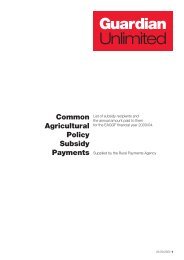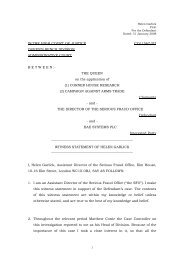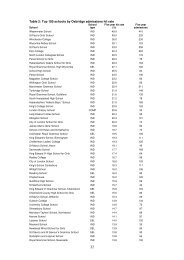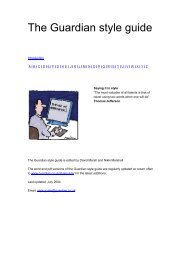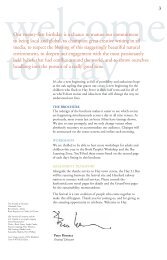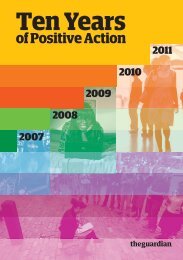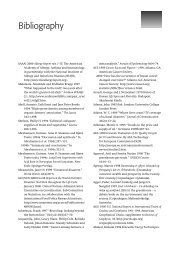KATINE COMMUNITY PARTNERSHIPS PROJECT - Guardian.co.uk
KATINE COMMUNITY PARTNERSHIPS PROJECT - Guardian.co.uk
KATINE COMMUNITY PARTNERSHIPS PROJECT - Guardian.co.uk
Create successful ePaper yourself
Turn your PDF publications into a flip-book with our unique Google optimized e-Paper software.
mentioned using the swamp as their se<strong>co</strong>nd water source. Nine villages had the greatest<br />
distance of 3-4 kilometres. This reality is not in line with the government re<strong>co</strong>mmended<br />
walking distance of 1.5 kilometres to travel to <strong>co</strong>llect water.<br />
As part of the project intervention, 5 boreholes have been rehabilitated in Katine and Ajobi<br />
villages in Katine parish, Adamasiko in Ojom parish, Merok in Merok parish and Olwelai in<br />
Olwelai parish benefiting 225 households. 8 new boreholes were drilled in Obyarai A and<br />
Omodoi in Ochuloi parish, Ominit and Matali in Ojom, Amorikot in Olwelai, Omulai in Katine<br />
parish, Abata in Merok parish, and Abia in Ojama parish (benefiting 360 households). District<br />
and sub-<strong>co</strong>unty <strong>co</strong>nsultative meetings were held where baseline data was shared and used to<br />
prioritise areas of need. Community <strong>co</strong>nsultative meetings and advocacy took place where<br />
decisions were made on the above sites for drilling the boreholes. This has increased safe<br />
water <strong>co</strong>verage from 42% to 56%. In addition, water quality and water-borne disease<br />
surveillance at 21 sites have been carried out. KCCP anticipates that this intervention will<br />
reduce water-borne diseases like diarrhoea and typhoid which are <strong>co</strong>mmon in the Katine<br />
<strong>co</strong>mmunity.<br />
The household baseline survey revealed that half of the surveyed households did not have a<br />
latrine and instead used the bush or plastic bags which they disposed of in bushes near their<br />
home. Seven out of ten households in Olwelai and six out of ten in Ochuloi did not have a<br />
latrine. Of the households that did have a toilet facility, 42% had a pit latrine without a slab and<br />
6% had a pit latrine with a slab. Latrine <strong>co</strong>verage was highest in Katine/Ojama (68%), followed<br />
then by Merok (58%). In response to these findings, the project has provided 240 sanitation<br />
kits to all 6 parishes in Katine sub-<strong>co</strong>unty and primary schools. These kits included wheel<br />
barrows, pick axes, machetes, axes, hoes and spades for latrine excavation. A follow-up of<br />
60 households that received a sanitation kit revealed that 33 had <strong>co</strong>mpleted latrine digging<br />
and had handed over these kits to the next villages.<br />
The <strong>co</strong>mmunity survey also revealed that 3 villages unanimously reported they had a trained<br />
water user <strong>co</strong>mmittee and one village (Obiol) had hand pump mechanics. The KCPP was able<br />
to facilitate three sub-<strong>co</strong>unty health <strong>co</strong>mmittee meetings for the months of January, February<br />
and March to discuss progress of water and sanitation <strong>co</strong>mponent activities. The project also<br />
established and trained 6 parish sanitation <strong>co</strong>mmittees - one from each of the six parishes.<br />
The KCPP established and trained three hand pump mechanics on operation and<br />
maintenance of water sources to <strong>co</strong>ver the six parishes and equipped them with protective<br />
wear, tool kits and bicycles for transportation.<br />
Monitoring of water usage informs us that, due to this intervention, the functionality of water<br />
sources has increased from 70% to 95%. The result of this increase is an improvement in<br />
<strong>co</strong>mmunity access to safe water for 1,500 people in Katine sub-<strong>co</strong>unty.<br />
Improved In<strong>co</strong>me Generation<br />
Farming groups have been formed in 18 selected villages from six of the parishes. Each of<br />
these groups has 30 self-selected members and includes both men and women with a guiding<br />
criterion of 50% gender representation. The selection criteria require <strong>co</strong>mmunity members to<br />
be actively engaged in farming and have a desire to improve production and marketing. The<br />
KCPP six monthly narrative report - October 2007 to March 2008 18





